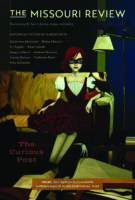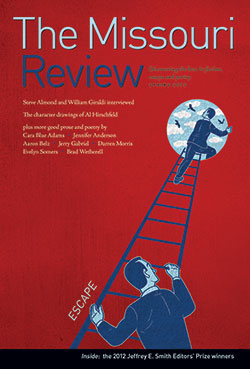Foreword | April 16, 2013
The Great Escape
Speer Morgan
For over three decades of my life I watched few movies and even less television. I watched so little TV that I told my wife that I had discovered a “new” sitcom called Seinfeld. She just rolled her eyes. Despite the put-downs, it’s fun to have such a trove of undiscovered stuff. I’m also seeing some movies that I saw long ago including, recently, the Franklin J. Shaffner film Papillon, in which Steve McQueen and Dustin Hoffman play two French criminals condemned to the penal colony Devil’s Island, off French Guiana. The movie is not just a great acting job by two major American stars but richly thematic, playing on the irony and uncertainty of escape. These two prisoners are living in hell, and they survive partly through the effort of planning their great escape. At the end, the McQueen character, Papillon, gets in his handmade raft of burlap and coconuts, laughing with happiness and release, while knowing, as the audience does, that he may not make it beyond the surf. The Hoffman character, counterfeiter Louis Dega, watches him leave, having helped with the escape. At some point he has realized that he is content with his captivity. Exhilarated by what he cannot bring himself to do, he stands at the precipice of a bluff, delighted by his good friend’s surviving determination.
Escape, or the desire for it, is a classic theme in literature. Perhaps the reason for this can be found by looking at our own lives and recalling how powerful the times of inhibition or entrapment and the yearning for release can be, and how memorable it is when one is lucky enough to escape, whether in fact or through acceptance. In my own life, the more theatrical “escapes”—for example from a sentence of death by a physician—may be less memorable and finally less important than others that are not so melodramatic or easily described. This makes me wonder if many of the personally important instances of both impasse and escape may seem on the surface to be either so typical or so mundane that they are difficult to dramatize.
Good writers always find ways to make new the old subjects. Alice Munro often writes about the frustrations of mothers and angry daughters, and their dreams of liberation. Elena Ferrante’s wonderful novel My Brilliant Friend is the tale, recollected in later life, of one of two girls who grow up as the most promising personalities in the smothering closeness and surprising danger of Italian village life; one of them manages to break away, and the other doesn’t. Julian Barnes won the Booker Prize this year for his fourteenth novel, The Sense of an Ending, a story in the Jamesian tradition about a man in his sixties who has lived a careful and quiet life that is disrupted by a seemingly minor but odd event—receiving a small bequest by a woman, the mother of an old girlfriend, whom he met only once, forty years before. Her gift of five hundred pounds launches him on a quest to understand the meaning and connections of his past and leads to the painful discovery that somewhere along the line his careful, noncommittal behavior became not just a negative force toward others but a self-destructive passivity.
Much of this issue has to do with entrapment and the urge for release. Rachel Yoder’s Jeffrey E. Smith Prize-winning story “The blood was the mountain and the mountain was the bear” portrays a young man who is trying to flee a long-term but oppressive relationship with a needy girlfriend by taking a long bike trip. On the journey, in which he tries to somehow escape from his current dilemma through exhaustion, he has a strange and powerful encounter with an old friend and with nature in sublime and raw form. It is a psychologically deft and elegantly written story.
The narrator of Cara Blue Adams’s “The Sea Latch” takes a family trip, visiting the ocean with her quasi-agoraphobic mother and younger sister. Neither the sister, who is pregnant by a former boyfriend, nor the mother will act outside their “comfort zone,” which is essentially to hang close to the motel and do very little. It’s a story about people who seal themselves into traps that they are unable to escape either from lack of courage or lack of imagination, and about the powerful if frustrated urge, that can nevertheless remain afloat in a family, to have moments of intimacy and sharing.
In Jerry Gabriel’s story “The Defense,” the protagonist, Turner drives halfway across the country when his sister calls to say she needs his support as she defends her dissertation. It is an awkward situation because the faculty member most versed in her area of research is also the father of her illegitimate son, from an affair that they had when she was a graduate student. Turner is on leave from his job and recovering from a second round of treatment for prostate cancer, and the trip offers a chance to escape from the recent conflicts in his life: battling illness and, prior to that, getting over a divorce. The trip begins with his desire to escape mortal dread yet ends up being something quite different.
Terry Ann Thaxton’s Smith Prize-winning essay “Delusions of Grandeur” is a frank depiction of the limited outlook for people with some kinds of mental disorders. Thaxton’s thirtyish son, Adam, suffers from a type of autism. He spends his time and mental energy inventing alternate universes and engaging in role-playing games. Adam’s social world is severely limited by his mental disorder, yet he has a close friend and roommate, David, who suffers from nonbizarre delusions. Much of what David says about himself and his life is not totally outside the realm of possibility, but it is also not true. Thaxton is candid about the roller-coaster experience of parenting a mentally ill child, recounting the numerous diagnoses and recommended treatments for her son that all turn out to be irrelevant. She’s forthright, as well, about fact that Adam and David are unlikely to ever be cured and about the strain placed on caretakers of the mentally ill. Her essay admits the desire to escape from caring for such a family member, while at the same time achieving both a sense of humor and wry acceptance of what are sometimes absurd situations.
Like Thaxton’s essay, Brad Wetherell’s “A Clean Break” is a memoir about how the only real escape in some situations is through acceptance, even if it at first seems impossible. Wetherell discovers at age twelve that his mother is an alcoholic, at the same time he learns that he may have bone cancer, and somehow, through this darkness, comes a positive reckoning. Jennifer Anderson’s “It’s a Sin to Tell a Lie” is another essay concerning mental survival in a difficult world. Anderson’s view is from the perspective of someone who has had numerous jobs at nursing homes. It is a head-on look, full of dark humor, at what it is like to work with dementia patients.
This issue’s poetry includes Katie Bickham’s narratives depicting different locations in a genteel Louisiana home remembered over several generations. Her domestic vignettes show a violent but nevertheless human past. While Bickham can’t escape the family’s dark history, she can give the children, women, and slaves of her past a voice. Aaron Belz’s poems rise above poetic nicety through absurdity and humor. He mixes the high with the low, lampooning pop culture, historical figures and poetic tradition, even as he delights in them. As much as he begs off from being serious, there is import to his tomfoolery, as he suggests the ineffable movement of nonstatic beauty and the poet’s true “middle place between seeing / and knowing.”
Darren Morris’s poems seek to somehow get beyond the realities of death and childlessness, taking the paradoxical approach of ironic meditation on the curse of his obsession.
Evelyn Somers’s review of novels by four established women writers looks at the ways in which the novels attempt to unravel the truths behind four distinct cultural flashpoints. Each novel deals, in a different way, with the almost obsessive urge to understand complex situations and events that can’t be reduced to simple facts.
Ryan Bradley’s conversation with Steve Almond and William Giraldi discusses voice in fiction, along with the roles of research and life experience—personal baggage that Almond claims is impossible to completely discard. The two discuss the fact that both comic writers and writers about sex are often looked down upon or disregarded. This dual interview is full of the same brand of wit that drives the two authors’ work.
Kristine Somerville’s visual feature on the character drawings of Al Hirschfeld showcases selections from his more than twelve thousand illustrations for film and theater. Hirschfeld’s playful line figures for the New York papers serve as a visual history of more than eighty years in the performing arts in this country. When Hirschfeld died in 2003 at ninety-nine, he was as much a celebrity as the actors and actresses he portrayed, and his iconic drawings have become a sine qua non of canonization on Broadway.
Speer Morgan
If you are a student, faculty member, or staff member at an institution whose library subscribes to Project Muse, you can read this piece and the full archives of the Missouri Review for free. Check this list to see if your library is a Project Muse subscriber.
Want to read more?
Subscribe TodaySEE THE ISSUE
SUGGESTED CONTENT

Features
Jan 08 2024
Foreword: Family Affairs
Family Affairs During the nineteenth century, observers from both sides of the Atlantic admired the relative looseness of American families while also criticizing a lack of multigenerational connectivity and… read more

Features
Dec 19 2023
Foreword: The Curious Past
The Curious Past The past is such a curious creature, To look her in the face A transport may reward us, Or a disgrace. – Emily Dickinson Jonathan Rosen’s… read more

Features
Jul 27 2023
Foreword: The New Realism
The New Realism I sometimes wonder what the dominant trend in literature is going to be called. Names for artistic periods and movements are hardly definitive, but they are useful… read more

